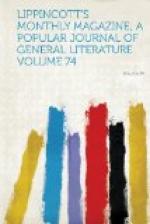These stones have now exchanged the murky air of London for that of one of the pleasantest sites in Surrey. Charter-House School has, after passing two hundred and sixty years in the metropolis, changed its location, and must be looked for now on a delightful spot near Godalming in Surrey. The governors very wisely determined about five years ago that boys were much better in country than in town, and, having ample funds, took measures accordingly. Last October the new buildings were ready for the boys’ reception, and they met there for the first time. The stones, however, were, with a sentiment most will appreciate, removed, in order to connect the past with the present, for the Charter-House must ever have many tender ties binding it to the site of the old monastery with its rich historic memories; and however famous may be the men who go forth from the new ground which Sutton’s famous foundation occupies, it must derive a great part of its fame for a long time to come from the place which sent out into the world Addison, Steele, Thirlwall, Grote, Leech and Thackeray, not to mention a host of names of those who in arms and arts have done credit to the place of their education.[11]
The home for aged and infirm or disabled men will remain where it has always been. This establishment has indeed been a welcome refuge to thousands who have known better days. Men of all ranks and conditions, who have experienced in the afternoon of life contrary winds too powerful for them to encounter, have here found a haven for the remnant of their days. Some have held most important positions, and a lord mayor of London, who had received emperors at his table,




